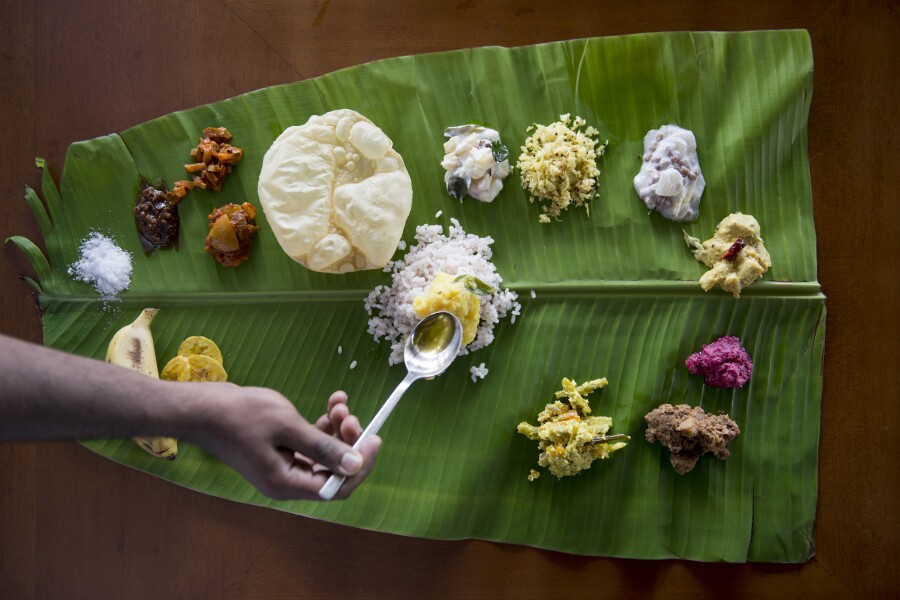I wrote the to-do list on the plane from New York: Show husband the river we played in during summer holidays. Walk in the rubber orchards with our 2-year-old daughter. Eat sadya.
But the river had dried up, the rubber orchards had been sold, and Kerala’s first McDonald’s had just opened in the city of Kochi. The tranquil, storybook south Indian state where I grew up was changing even as I unpacked the bug spray.
One restaurant advertised Tandoori, Chinese, and Italian dishes, but sadya—a banquet of vegetarian dishes—was nowhere on the menu. Partly, this was timing. Sadya is mostly reserved for special occasions. I might have had more luck had I arrived in Kochi to visit my family during the annual Hindu festival of Onam, which celebrates the rice harvest. Rice is the hero of sadya, placed in the seat of honor only after the side dishes have been arranged around the center of a banana leaf.
According to Ammini Ramachandran, author of the memoir Grains, Greens, and Grated Coconuts: Recipes and Remembrances of a Vegetarian Legacy, the most basic version of sadya features four vegetable preparations: kalan (plantains and yams cooked in yogurt), olan (pumpkin in coconut milk sauce), erisseri (pumpkin or plantains in toasted coconut and cumin sauce), and aviyal (steamed vegetables in coconut and yogurt sauce). In a conversation on Facebook, Ramachandran explained that for festivals, important birthdays, and weddings, many more side dishes and various pickles, chutneys, and desserts may appear. Long ago, at the Kochi royal family’s Onam festival meals, as many as 64 sadya dishes were served. Imagine the forests of vegetables and coconuts that have to be chopped, diced, and grated for a meal like that. Sadya is not fast food.
One day near the end of our family visit to Kerala, on our way to a housewarming, we stopped for lunch at a nondescript hotel. All we wanted was a quick bite. But before we could order, a smiling waiter arrived with five banana leaves. Without hesitation, my father thumped the middle stem of each leaf, to flatten it. Another waiter arrived with the side dishes. Framed against the jade-green leaf were splashes of color—the turmeric orange of sautéed cabbage, the vivid fuchsia of beetroot thoran, and the golden hues of kalan and olan were reassurance that these vegetables had never seen the inside of a freezer. A mound of hot brown rice fell from one waiter’s spoon.
Suddenly, my loud, argumentative family was silent. The first waiter delivered glasses of payasam—rice, milk, and sugar simmered for hours and garnished with nuts and raisins. He brought a spoon for my toddler.
“Baby coffee?” my daughter asked suspiciously.
The river and the orchards are gone. My grandmother, who used to begin cooking at 5 a.m. so as to have the sadya at the table by noon, is too tired to cook that way anymore. There are things my daughter will never know. Some tastes will linger, though.
Maybe this one.
“Baby payasam,” I informed her.
“Baby pasham,” she repeated, grateful for the new word, and for the ancient flavor that endures.

Chef Kartikeyan Selvaraj pulls out leaves from a curry twig at Rice Boat Restaurant inside Vivanta by Taj in Willingdon island, Kochi, Kerala, India on 11/28/2013.
Photo by Chiara Gioa
How to Make Varutha Erisseri
(SERVES 4)
Recipe by Ammini Ramachandran
INGREDIENTS
2 green plantains, peeled, cut into half-inch cubes, and washed
Salt to taste
1 tsp dried red cayenne, serrano, or Thai chili powder (less for a milder taste)
½ tsp turmeric powder
2 cups freshly grated coconut
1 tbsp vegetable oil
1 tsp cumin seed
For seasoning and garnish:
1 tbsp vegetable oil
1 tsp mustard seeds
1 dried red cayenne, serrano, or Thai chili, halved
12 to 15 fresh curry leaves
MAKE IT
1. Place the plantains in a saucepan with just enough water to cover.
2. Add salt, chili powder, and turmeric, and cook over medium heat until the plantains are tender.
3. While the plantains are cooking, toast the grated coconut in 1 tbsp of oil until it is golden brown.
4. In a food processor, blend half of this toasted coconut with cumin seeds and just enough water to make a thick, smooth puree.
5. Add the puree to the plantains, stirring gently, so that the plantains are not mashed.
6. Simmer for another three to five minutes, and remove from the stove.
7. Heat the vegetable oil in a skillet and add the mustard seeds. When the mustard seeds start sputtering, add the halved chili pepper and the curry leaves, and remove from the stove.
8. Pour the mixture over the seasoned plantains. Sprinkle in the remaining toasted coconut flakes, and stir gently. Cover and set aside for minutes, to allow flavors to blend.
9. Serve hot with plain boiled rice.











